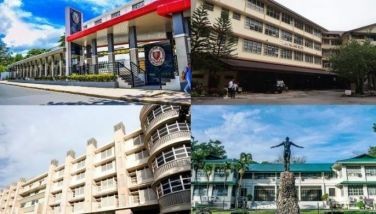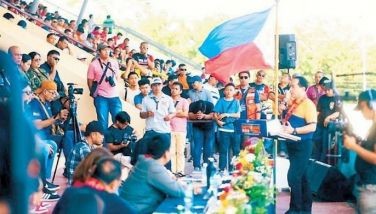Rody signs EO renaming Benham ‘Philippine Rise’

A patriotic marker rests on a massive expanse of hard and soft corals in this photo taken during a marine expedition at Benham Rise on May 26, 2016. OCEANA/UPLB
MANILA, Philippines - In a bid to assert the Philippines’ sovereign rights over Benham Rise, President Duterte has signed Executive Order 25 renaming the undersea region as Philippine Rise.
The EO that Duterte signed on May 16 also directed the National Mapping and Resources Information Authority (NAMRIA) to indicate the name Philippine Rise, in lieu of Benham Rise, when referring to the area in all official maps and charts that it would produce and publish.
Benham Rise is a seismically active undersea region estimated to cover 13 million hectares east of Luzon. It is 35 meters underwater, with the shallowest point located off the provinces of Aurora and Isabela.
It is larger than Luzon, the Philippines’ biggest island.
In renaming the plateau, Malacañang cited the Philippines’ jurisdiction over the area based on the UN Convention on the Law of the Sea (UNCLOS) signed and ratified by the Philippines on Dec. 10, 1982 and May 8, 1984, respectively, and enforced on Nov. 16, 1994.
It also cited the April 12, 2012 ruling of the Commission on the Limits of the Continental Shelf (CLCS), which approved the submission of the Philippines with respect to the limits of its continental shelf in the area. This enabled the Philippines to carry out exploration and development of natural resources in the region.
“The undersea feature known as the Benham Rise region, which has an area approximately 24 million hectares in size, is located within the Philippine exclusive economic zone and continental shelf, as well as the outer limits of the continental shelf in accordance with the recommendations of the Commission on the Limits of the Continental Shelf issued on 12 April 2012,” EO 25 read.
“In the exercise of its sovereign rights and jurisdiction, the Philippines has the power to designate its submarine areas with appropriate nomenclature for purposes of the national mapping system,” it added.
The order also reiterated the Philippines’ sovereign rights and jurisdiction over the Benham Rise region relevant to the provisions of the 1987 Philippine Constitution, national legislation, the UNCLOS and applicable international law.
Duterte signed the order last May 16 shortly after he arrived from Beijing where he held bilateral talks with Chinese Premier Li Keqiang and President Xi Jinping on the sidelines of the One Belt, One Road Forum.
Benham Rise was believed named after Rear Admiral Andrew Ellicot Kennedy Benham, a US Navy officer who served in China, the Pacific and the US expedition to Paraguay. He was born in New York’s Staten Island in 1832 and died at age 73 also in New York.
The issue of alleged Chinese intrusion in the Philippine Rise region prompted debates over the need for the Philippines to assert sovereignty over the undersea region and extinct volcano ridge located in the Philippine Sea, approximately 250 kilometers east of the northern coastline of Dinapigue, Isabela.
Defense Secretary Delfin Lorenzana earlier confirmed that Chinese survey ships have conducted oceanographic research in the region, pushing the Department of Foreign Affairs to seek clarification from the Chinese embassy in Manila.
Lorenzana said that Chinese presence in the area was “very worrying” and issued a directive to the Philippine Navy to drive away Chinese ships seen in the area.
DOST chief urges research
Science Secretary Fortunato dela Peña asked researchers to do more scientific studies on high potential fishery resources like seaweed and the Philippine Rise.
He emphasized the importance of the region in Duterte’s thrust of reducing economic inequality through the creation of more income opportunities coming from marine resources.
Speaking before 300 delegates composed of scientists, academicians, researchers and various industry stakeholders, Dela Peña said the Department of Science and Technology (DOST) is also strengthening its research and development initiatives in various sectors, including fisheries, to provide more opportunities for marginalized fishermen and help in uplifting their economic conditions.
The Food and Agriculture Organization ranked the Philippines as 8th among the top fish producers in the world in 2016, with Central Visayas at the forefront.
Based on initial studies, the Philippine Rise, is rich in mineral, oil and gas deposits like solidified methane that could help the country achieve self-sufficiency in energy.
Bohol 2nd District Rep. Erico Aumentado, who chairs the House science and technology committee, supported the DOST efforts for research and development of the area as he called for stronger cooperation among different sectors of society – government, private sector and academe – to ensure its success.
Dela Peña and Aumentado were speakers at the Visayas Regional Scientific Meeting held last April in Cebu City, according to the DOST Media Service.
Aumentado expressed his support for the regional scientific meetings as a means to share ideas in creating income opportunities in the provinces, pointing out that this can become a venue for free exchange of ideas that may lead Filipinos “to follow one path for sustainable development.”
- Latest
- Trending





























